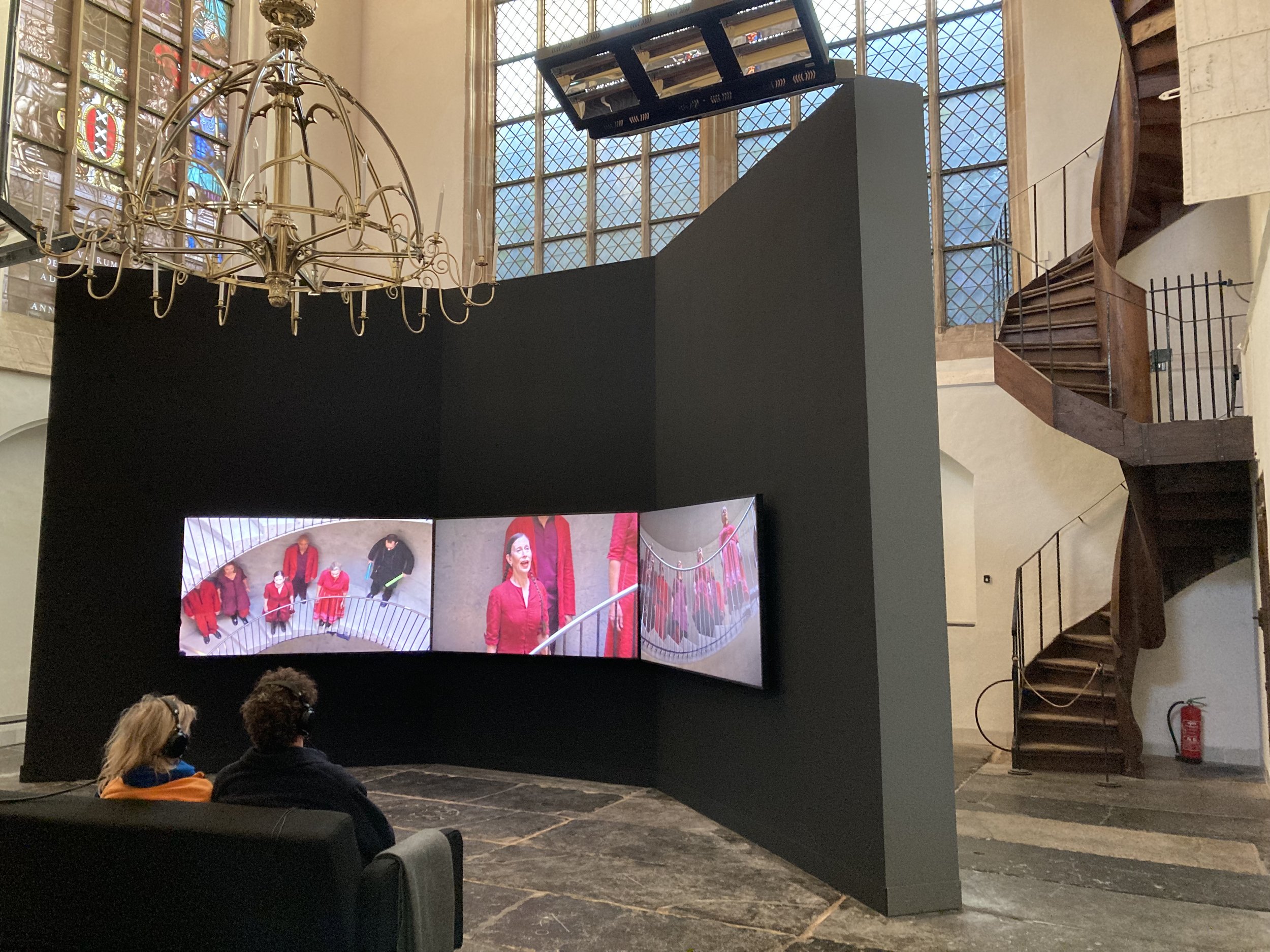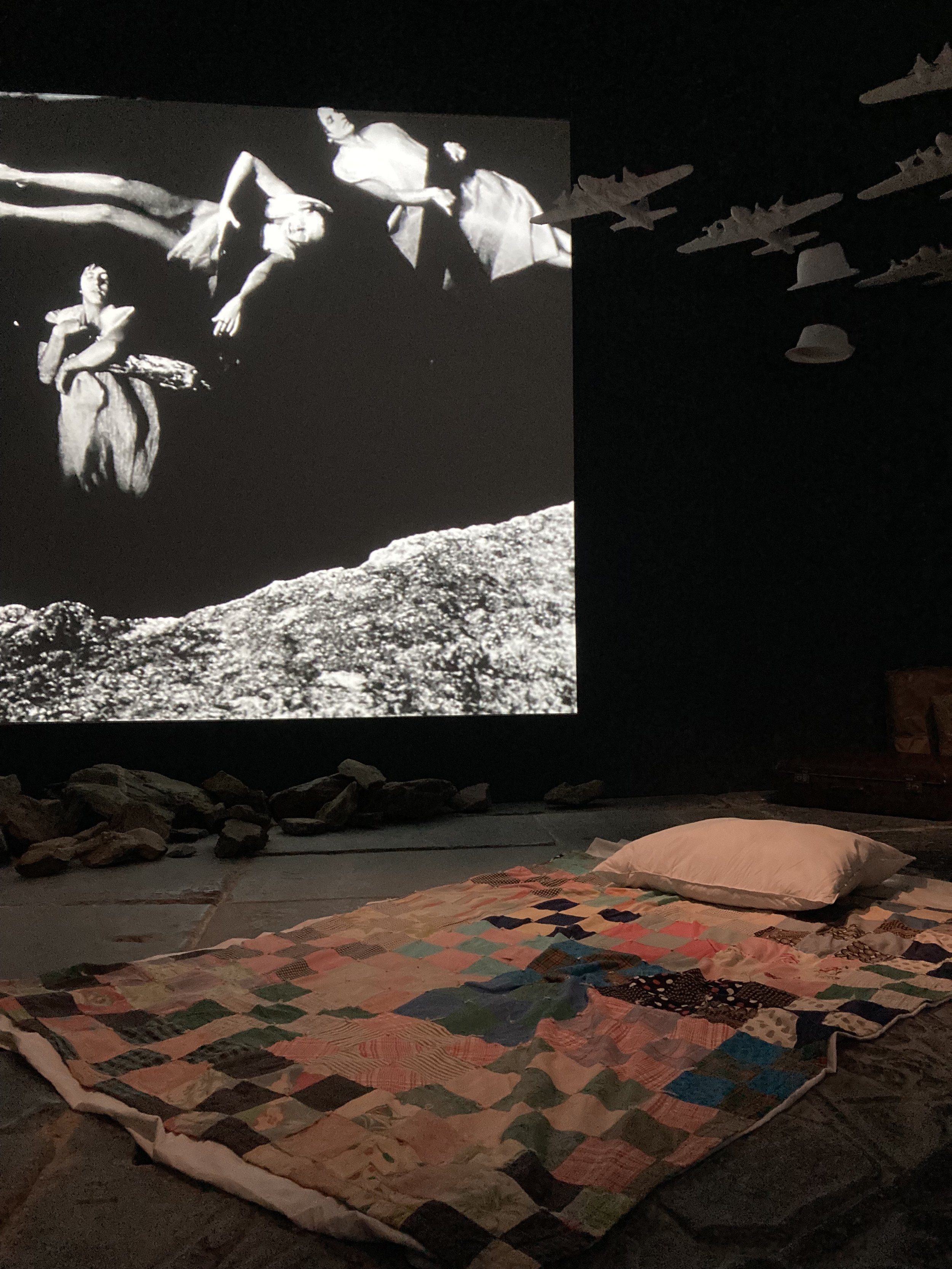Meredith Monk: Calling
November 6, Amsterdam, Oude Kerk
Every year on March 9th, at half past 8 AM, at the Solstice, the first ray of sunlight falls on the tomb of Saskia Uylenburgh—Rembrandt's beloved wife— in Amsterdam's Oude Kerk, the city’s oldest building (built in 1302) and as well, one of its newest art institutions.
Now it’s chilly November, the sky dark grey, and I’m walking from Amsterdam’s central station, through the De Waalen (Red Light) district, to the entry of the Oude Kerk. This mammoth building is now the venue for the first-ever European survey of the work of polymath artist— composer; performer; director/choreographer, filmmaker— Meredith Monk. The retrospective, “Meredith Monk: Calling” is being presented in two cities, Amsterdam and Munich, in celebration of the artist’s 80th birthday and her sixty years of prolific art-making.
Oude Kerk’s vaulted wooden ceiling is the largest medieval example in Europe. The church has excellent acoustics. As I enter the vast sanctuary, lush polyphonic vocalizations—Monk’s compositions— reverberate in the ancient space, making the entire church a singing body.
There’s no one to tell me how to order my visit. I wander at will, drawn by my own curiosity, by the beckoning of harmonizing voices, by a mandala of moving hands projected in front of Oude Kerk’s baroque Great Organ. I stop and watch in fascination. Move on. Return. Discover. There are surprises behind walls, on the choir platform. I venture into the Holy Sepulcher Chapel, to the humming of bees and encounter two eerie beekeepers in red beekeeping suits who each keep vigil over a table of household objects encased in beeswax: “The Politics of Quiet Shrine.” Each figure’s face is a video monitor unspooling a documentary about collaborative hive activity. They’re a rational community; working together, protecting and caring. Sunlight glows through the chapel’s ruby window, a 2018 work by Italian artist Giorgio Andreotta Calo, casting a crimson glow over the scene. It’s magical.
Art historian John Walsh, who specializes in Dutch painting, reminds me that the Dutch artist Emanuel de Witte (1615-1692) painted the Oude Kerk over forty times. His paintings show a range of activities in addition to ceremonies of worship; the church once functioned as town square: people mended fish nets; played dice; sold potatoes; swapped stories. Mothers breastfed their infants; stray dogs straggled about looking for a scrap of herring or sausage; processions escorted the dead to their final resting place. The sacred and the profane. Body and soul. Fundamentals. Walsh also tells me how painters like De Witte tended to exaggerate the proportions of the building, “so it’s a surprise to enter and find it almost intimate.” So true.
Emmanuel De Witt, “Oude Kerk”
Entering the Mirror Room, with its gilded mirror and exquisite hand-painted wallpaper of primroses, carved shells, tulips, birds, I’m now inhabiting a Vermeer painting. I watch videos of older Monk pieces, like her punk cabaret, “Turtle Dreams,” listen to interviews with the artist. In this room, the old Marriage Commissioner’s office (1546 to 1811), Rembrandt signed the marriage contract to marry his Saskia.
“Mirror Room” at Oude Kerk [photo: LS]
In an adjacent high-ceilinged room, I don headphones to listen and watch a three-channel video installation of Monk’s “Songs of Ascension Shrine,” which reimagines the live performance Monk created for artist Ann Hamilton’s tower on a ranch in Geyserville, CA. Monk’s celestial vocal score, with gorgeous orchestration—performed by her superb vocal ensemble— accompanies the red-garbed performers who circumambulate and ascend the tower’s double helical staircase. This is one of Monks’ most gorgeous pieces; to me, a holy work.
“Songs of Ascension Shrine” [photo: LS]
Tucked away in a side room, the installation devoted to Monk’s masterwork about WW2, “Quarry,” in which I performed as a young woman. There is the patchwork quilt on the floor on which Monk, in her role as The Child, listened to the incomprehensible sounds of world war—dictators haranguing their followers— beamed in on a dial radio. In the films and documentary video, I see faces and movements of those who are no longer among the living; faces of friends/performers I’ve known and loved, those whom I saw perform while alive when now they’re dead. Those whom I saw perform when young, and now they’re old.
“Quarry’ room, Oude Kerk [photo: LS]
The lifecycle of these works is my life cycle as well, I realize, threaded through the space itself. Inside the Oude Kerk, one is walking, quite literally, over the bones of the dead… the tombstones of eminent Amsterdammers, thirty-five generations, under one’s feet. Oude Kerk contains multitudes. Monk’s work contains multitudes as well.
The chill of the stones under my feet grows stronger after several hours. The daylight in the cathedral filtering through its enormous windows, moving from east to west, is dimming. Time to warm up in the café next door, drink hot chocolate, write notes, get out my drawing pencils. I’m full of so many emotions, “the full palette of emotions,” Meredith’s gift to us.
Nov 9, MUNICH, Haus der Kunst
Tonight is the preview of the Monk retrospective at Haus Der Kunst, the “fraternal twin” of the Oude Kerk survey. Meredith’s entreating voice beckons one to enter the formidable columned building on Prinzregentenstrasse. What could be a more different venue than Amsterdam’s Oude Kerk than this “first representative building of the ‘Third Reich’”? The present-day Haus der Kunst, has long been committed to an active and critical engagement with its history. But you can still feel the vibes of the building; it’s eerie. Tonight I note, is also the anniversary of Kristallnacht, that infamous 1938 pogrom against Jews. I am also amazed and delighted to see the artist Mel Bochner’s frieze on the back of the building facing the English Gardens; a string of words in Yiddish set against the bright yellow the same color of the six-pointed star that Jews were forced to wear during the Nazi era.
Mel Bochner’s “The Joys of Yiddish” (2006)
An entrance through enormous bronze doors leads into the “Middle Hall” of Haus der Kunst, the place where Hitler announced his “relentless cleansing war against modernism.” Up the staircase to the first floor for the exhibit, what first greets my eyes is a film (“Hand Mandala” from Monk’s music-theater work, “Cellular Songs”) projected on the wall, a moving image so mesmerizing I am stopped in my tracks. Five pairs of human hands overlap, interlace, combine to form patterns, an absorbing metaphor for cooperation, collaboration, kindness over cruelty.
This is a moment to enter Monk’s contemplative world of play and imagination and wordless depths; it’s an invitation to slow down, allow Monk’s work to enter the body sonorously, visually, viscerally.
Pieces appear in different configurations here from where I saw them days earlier at Oude Kerk. The sequence is more linear, per the dictates of the architecture; though a series of curving curtains makes soft spaces for various of the shrines and installations. The film of a galloping horse in silhouette (from Monk’s 1991 opera, ATLAS) is projected here on a string curtain, not a wall. At Oude Kerk, “Silver Lake with Dolmen Music” settled onto the rise of the High choir. At HDK, it occupies its own tent-like room. Above each of the chairs in the circle dangles a set of earphones: immerse yourself in Monk’s haunting “Dolmen Music,” let Julius Eastman’s cavernous bass lead hovering in your ear like a benediction from an ancient well. None of the seated listeners wants to give up their chair. These are the brain waves we’ve been craving in these weeks of war and mayhem.
“Silver Lake with Dolmen Music” at Haus Der Kunst [photo: LS]
There are playful touches in the archive room; performance posters; familiar objects from Meredith’s loft in lower Manhattan—photos of her Buddhist teacher Pema Chodron, and her longtime partner, Mieke van Hoek, gone some twenty-one years now. There’s a bookshelf of Monk’s favorite reading, philosophy, science, some mysteries. There are visitors examining Monk’s kitchen table, a replica of the one where I’ve drunk strong black coffee and spread berry jam on spelt toast. There’s even her collection of tiny turtle figurines. It’s personal, homey.
A dear friend who journeyed from Köln for the opening, told me the following morning that he’d awakened in his hotel room in the middle of the night with the thought: “Meredith’s installation at Haus der Kunst was a conquering of the space.” She didn’t allow the energy of that building, he noted, “to obstruct what she wanted to do.” The power of her work, its call for beauty and compassion, for interconnectedness shines through.
Ascend ascend.
KRAKOW, Poland.
November 11
As a coda to my adventure, I head for six days in Krakow, Poland before returning home, to wander and think about what I’ve just experienced; to see friends I haven’t seen in years, their children grown by a head. Tomek (Tomasz Cebulski) was just twenty-one when he first guided me around Poland in 2002, and many times afterwards as I researched and worked on my book, The Crooked Mirror: A Memoir of Polish-Jewish Reconciliation. Tomek offers to take me to visit the grave of the great Polish poet Adam Zagajewski, a dear friend, who passed away too young during the pandemic.
Adam’s tomb is in the National Pantheon, a crypt underneath the Church of Saints Peter and Paul where many of Poland’s greats in the fields of arts, culture and science are buried (though I saw no women.) We walk by the tombs of the composer Krzysztof Penderecki; the chemist Zygmunt Wroblewski; the playwright Slawomir Mrozek. Rounding a corner, catching sight of Adam’s tomb; I gasp. Such cold marble for such a warm wry man.
in the National Pantheon, Krakow
On visits to Krakow in years past, I’d always get together with Adam, sometimes joined by his wife Maya, for a walk around the Planty (the greenspace encircling the Old Town). Adam would point out his favorite trees and plants and tell me their names in Polish. We’d sit in a café or a restaurant with white tablecloths, and he’d tell me about life, how his work was to “walk around Krakow talking to God,” how his poems were arriving or not.
with Adam Zagajewski walking the Planty, Krakow, spring 2006.
Engraved on a tablet of stone is one of Adam’s best-known poems, “Try to Praise the Mutlilated World,” published in the New Yorker right after 9/11. Dear Adam, I think, how grateful I am to be in your beloved city. How I miss you.
On my last night in Krakow, I meet up with another dear old friend, Pawel Leszkowicz, a Polish art historian and curator, who’s in town for an international art critics’ conference. I listen to his talk, drink hot borscht with him afterwards, quick catch-up on our lives, then head home from the Main Square on that dark and rainy night to my flat in Kazimierz. I have a flight to catch early the next morning. En route down Krakowska, I hear the sounds of a musician playing under the cover of an arcade. I duck in from the rain. The musician is a young Ukrainian trombonist in a fedora, playing Leonard Cohen’s “Hallelujah.” I place some zlotys in his hat, stand for some time, listening to this musician trying to praise this mutilated world; then walk home with tears running down my cheeks.








